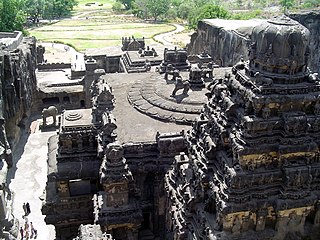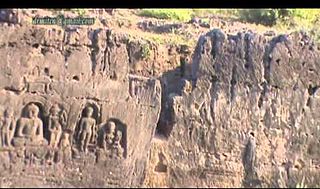
The Ajanta Caves are 30 rock-cut Buddhist cave monuments dating from the second century BCE to about 480 CE in Aurangabad district of Maharashtra state in India. Ajanta Caves are a UNESCO World Heritage Site. Universally regarded as masterpieces of Buddhist religious art, the caves include paintings and rock-cut sculptures described as among the finest surviving examples of ancient Indian art, particularly expressive paintings that present emotions through gesture, pose and form.

The Elephanta Caves are a collection of cave temples predominantly dedicated to the Hindu god Shiva, which have been designated a UNESCO World Heritage Site. They are on Elephanta Island, or Gharapuri, in Mumbai Harbour, 10 kilometres (6.2 mi) east of Mumbai in the Indian state of Mahārāshtra. The island, about 2 kilometres (1.2 mi) west of the Jawaharlal Nehru Port, consists of five Hindu caves, a few Buddhist stupa mounds that date back to the 2nd century BCE, and two Buddhist caves with water tanks.

The Koyna River is a tributary of the Krishna River which originates in Mahableshwar, Satara district, western Maharashtra, India. It rises near Mahabaleshwar, a famous hill station in the Western Ghats. Unlike most of the other rivers in Maharashtra which flow East-West direction, the Koyna river flows in North-South direction. The Koyna River is famous for the Koyna Dam and the Koyna Hydroelectric Project. Koyna Hydroelectric Project is the 2nd largest completed hydroelectric project in India. The reservoir – Shivasagar Lake, is a huge lake of 50 km in length.

Aurangabad district, officially known as Chhatrapati Sambhaji Nagar district, is one of the 36 districts of the state of Maharashtra in western India. It borders the districts of Nashik to the west, Jalgaon to the north, Jalna to the east, and Ahmednagar to the south. The city of Aurangabad houses the district's administrative headquarters. The district has an area of 10,100 km2, of which 37.55% is urban and the rest is rural. Aurangabad District is a major tourism region in Marathwada, with attractions including the Ajanta Caves and Ellora Caves.

Wai is a town in Satara district of Maharashtra state in India. Located on the Krishna River, Wai was a prominent town during the Peshwa era. Two important Marathi Brahmin from ruling families had their origins here: Rani Lakshmibai of Jhansi and Gopikabai, wife of Nanasaheb Peshwa.

Karad is a town in Satara district of Indian state of Maharashtra. It is located 302 km (180.19 miles) from Mumbai, 74 km from Sangli and 162 km from Pune. It lies at the confluence of Koyna River and the Krishna River known as the "Pritisangam". The two rivers originate at Mahabaleshwar, which is around 100 km from Karad. Karad is well known for sugar production and is known as the sugar bowl of Maharashtra owing to the presence of many sugar factories in and around Karad. It is considered an important educational hub in Western Maharashtra due to the presence of many prestigious educational institutes. Karad is resting place of the first chief minister of Maharashtra Yashwantrao Chavan situated at the confluence of the Krishna and Koyana rivers. It is ranked as the cleanest town in Swachh Survekshan 2020 in the category of population with less than 1 lakh.

Koregaon Assembly constituency of Maharashtra Vidhan Sabha is one of the constituencies located in the Satara district, in the Koregaon area.
Dzongkhul Monastery or Zongkhul Gompa is located 30 km northwest of Padum in the Stod Valley of Zanskar in Ladakh, northern India. Like the Sani Monastery, it belongs to the Drukpa school of Tibetan Buddhism

Satara Assembly constituency is one of the 288 Vidhan Sabha (Assembly) constituencies of Maharashtra state in Western India. It is a part of Satara Lok Sabha constituency, along with five other assembly constituencies, viz Wai, Karad North, Karad South, Koregaon and Patan from Satara district.
Bhood is a village in Khanapur tehsil of Sangli district in Maharashtra, India. It is located near the city Vita.

The Shivneri Caves are artificial caves dug for Buddhist monks circa the 1st century CE. These are now famous tourist attractions located on Shivneri Hill, about 2 km Southwest of Junnar, India. Other caves around the city of Junnar are: Manmodi Caves, Lenyadri, and the Tulja Caves.

The Dhank Caves are located near Dhank village near Upleta, Rajkot district, Gujarat, India. They were chiseled out of a calcareous sandstone outcropping during the regime of the Western Satraps. The caves are influenced by Buddhist and Jain cultures. The Jain cave includes figures of Adinath, Shantinath and Pārśva. These are considered to be the earliest Jain sculptures in Kathiawad.

There are two sets of Buddhist caves in two different places taking the name of Shana caves.
Karad South Assembly constituency of Maharashtra Vidhan Sabha is one of the constituencies located in the Satara district.

Karad North Assembly constituency of Maharashtra Vidhan Sabha is one of the constituencies located in Satara district.
Malkapur is a town in Satara district in the southern part of Indian state of Maharashtra. It lies beside the city of Karad and along the NH4 highway. It had one of the highest revenue-generating Gram Panchayats in Maharashtra. Later on due to increasing population and urbanization it was given the status of a town having Municipal Council. The town is well known for its 24×7 water supply to each and every house. It is also implementing Solar City Project in which municipal council gives subsidy on purchasing any solar-powered equipment and reducing power dependency on MSEB. Malkapur town is divided into 17 wards for which elections are held every 5 years.
Karawadi is a village panchayat located in the Karad taluka of Satara district in the southern part of Indian state of Maharashtra. It belongs to Western Maharashtra region. It has a population of 3,588 according to 2011 census. The nearby villages include Ogalewadi, Viravade, Wagheri, Vadoli Nileshwar. Prominent family surnames include Pisal, Dubal, Patil, Chavan, Bhosale, More, Bansode. It is in the Pune Division. It is located 57 km towards South from District headquarters Satara and 278 km from State capital Mumbai.

The Manmodi Caves are a complex of a rock-cut caves about 3 km to the south of the city of Junnar in India. Other caves surrounding the city of Junnar are: Tulja Caves, Shivneri Caves and Lenyadri caves.

Sirpur Group of Monuments are an archaeological and tourism site containing Hindu, Jain and Buddhist monuments from the 5th to 12th centuries in Mahasamund district of the state of Chhattisgarh, India. Located near an eponymous village, it is 78 kilometres (48 mi) east of Raipur, the capital of the state. The site is spread near the banks of the river Mahanadi.

Yerphal Caves, also Yerphale Caves, are a small group of Buddhist caves located near Umbraj, Maharashtra, India. The caves were only discovered recently, in 1979. It is located not far from the Karad Caves.






















